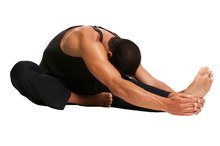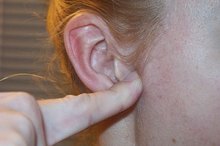Stretching Exercises for Hip Pain From a Pinched Nerve
Pain in the hip from a pinched nerve can be temporary, or the result of a longer-term condition such as sciatica, which results when the sciatic nerve becomes trapped between two muscles or muscle and bone. Stretching is a beneficial way of lengthening and loosening the muscle that may be putting pressure on the nerve. Regular stretching offers short-term pain relief and may help resolve a longer-term condition.
Piriformis Stretch
The piriformis is a small muscle in the lower back that attaches to the pelvis. People often suffer from nerve pain in the hip because of piriformis syndrome, which results when a tight piriformis muscle places pressure on the sciatic nerve.
Sit tall in a chair with your feet flat on the floor. If your hip pain is on the right side, take your right ankle and place it on top of your left knee. Your ankle bone should lie an inch or two above your kneecap. Allow your right knee to fall out to the side as much as possible, then lean forward until your feel a stretch in your right side outer hip and your right side lower back. Hold for 10 to 20 seconds and release.
- The piriformis is a small muscle in the lower back that attaches to the pelvis.
- Allow your right knee to fall out to the side as much as possible, then lean forward until your feel a stretch in your right side outer hip and your right side lower back.
Hip Flexor Stretch
Stretches for a Clicking Hip
Learn More
The hip flexors are on the top-front of the thigh starting at the pelvis. These small muscles often become tight and shortened from inactivity, and too much sitting can result in a pinched nerve.
Assume a lunge position, with your front foot about 3 to 4 feet in front of your back foot and both knees bent at 90-degree angles. Your back leg should be the leg where you feel pain as that is the side that will receive much of the benefits of this stretch. Place the back knee on the floor on a carpeted surface, an exercise mat or a folded towel to protect your kneecap. Keep your front foot directly underneath your front knee; if needed, inch your foot forward a bit. Keeping yourself upright, lunge forward so that you feel a stretch on the front side of your back thigh. Hold for 10 to 20 seconds and release.
- The hip flexors are on the top-front of the thigh starting at the pelvis.
- Keeping yourself upright, lunge forward so that you feel a stretch on the front side of your back thigh.
Outer Hip Stretch
If your outer hip muscles are tight, this can place pressure on the underlying nerves and cause pain.
Stand upright and place the leg of the affected side behind the other leg. Push the affected hip out to the side as you lean sideways over to the opposite side. Take your arm on the same side as your affected hip over your head toward the other side to deepen the stretch. You should feel a stretch along the side of your body where you feel pain. Hold for 10 to 20 seconds and release.
- If your outer hip muscles are tight, this can place pressure on the underlying nerves and cause pain.
- Take your arm on the same side as your affected hip over your head toward the other side to deepen the stretch.
Gluteal Stretch
Exercises to Relieve Nerve Pain in the Thigh
Learn More
Your gluteal muscles, or glutes, are your buttock muscles. Tight glutes can place pressure on the underlying nerves and cause hip pain that feels much like piriformis syndrome.
Lie on your back with your legs extended. Bend the knee on the side of your body where you feel pain and bring it up toward your chest. Interlace your fingers a couple inches below the kneecap and pull the knee closer to your chest and out slightly toward your shoulder. Hold for 10 to 20 seconds and release.
- Your gluteal muscles, or glutes, are your buttock muscles.
- Bend the knee on the side of your body where you feel pain and bring it up toward your chest.
Related Articles
References
- The Stretching Institute: Sciatica Stretches for Sciatica Pain Treatment
- Spine-Health: Sciatica Causes and Exercises
- SportsInjuryClinic.net: Standing Outer Hip Stretch
- Barbosa ABM, Santos PVD, Targino VA, et al. Sciatic nerve and its variations: is it possible to associate them with piriformis syndrome? Arq Neuropsiquiatr. 2019;77(9):646-653. doi:10.1590/0004-282x20190093
- Piriformis Syndrome. MedlinePlus.
Writer Bio
Jody Braverman is a health and fitness professional and writer in Seattle. She has been a personal trainer and yoga instructor for almost a decade and is passionate about movement and helping people lead active, healthy lives.









